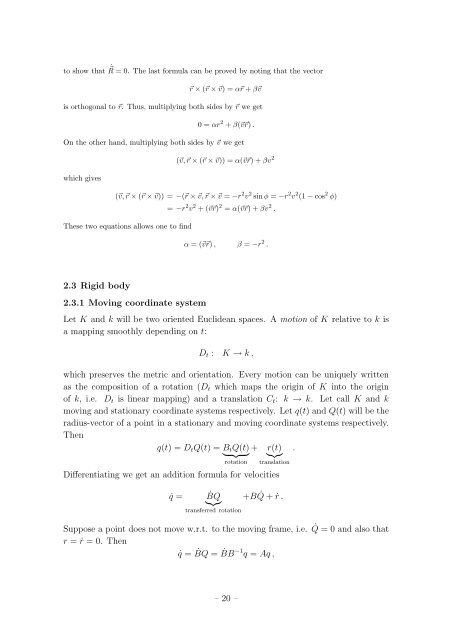Student Seminar: Classical and Quantum Integrable Systems
Student Seminar: Classical and Quantum Integrable Systems
Student Seminar: Classical and Quantum Integrable Systems
You also want an ePaper? Increase the reach of your titles
YUMPU automatically turns print PDFs into web optimized ePapers that Google loves.
to show that ˙⃗ R = 0. The last formula can be proved by noting that the vector<br />
⃗r × (⃗r × ⃗v) = α⃗r + β⃗v<br />
is orthogonal to ⃗r. Thus, multiplying both sides by ⃗r we get<br />
0 = αr 2 + β(⃗v⃗r) .<br />
On the other h<strong>and</strong>, multiplying both sides by ⃗v we get<br />
(⃗v, ⃗r × (⃗r × ⃗v)) = α(⃗v⃗r) + βv 2<br />
which gives<br />
(⃗v, ⃗r × (⃗r × ⃗v)) = −(⃗r × ⃗v, ⃗r × ⃗v = −r 2 v 2 sin φ = −r 2 v 2 (1 − cos 2 φ)<br />
= −r 2 v 2 + (⃗v⃗r) 2 = α(⃗v⃗r) + βv 2 .<br />
These two equations allows one to find<br />
α = (⃗v⃗r) , β = −r 2 .<br />
2.3 Rigid body<br />
2.3.1 Moving coordinate system<br />
Let K <strong>and</strong> k will be two oriented Euclidean spaces. A motion of K relative to k is<br />
a mapping smoothly depending on t:<br />
D t : K → k ,<br />
which preserves the metric <strong>and</strong> orientation. Every motion can be uniquely written<br />
as the composition of a rotation (D t which maps the origin of K into the origin<br />
of k, i.e. D t is linear mapping) <strong>and</strong> a translation C t : k → k. Let call K <strong>and</strong> k<br />
moving <strong>and</strong> stationary coordinate systems respectively. Let q(t) <strong>and</strong> Q(t) will be the<br />
radius-vector of a point in a stationary <strong>and</strong> moving coordinate systems respectively.<br />
Then<br />
q(t) = D t Q(t) = B t Q(t) + r(t) .<br />
} {{ } }{{}<br />
rotation translation<br />
Differentiating we get an addition formula for velocities<br />
˙q =<br />
ḂQ +B<br />
}{{}<br />
˙Q + ṙ .<br />
transferred rotation<br />
Suppose a point does not move w.r.t. to the moving frame, i.e.<br />
r = ṙ = 0. Then<br />
˙q = ḂQ = ḂB−1 q = Aq ,<br />
˙Q = 0 <strong>and</strong> also that<br />
– 20 –

















